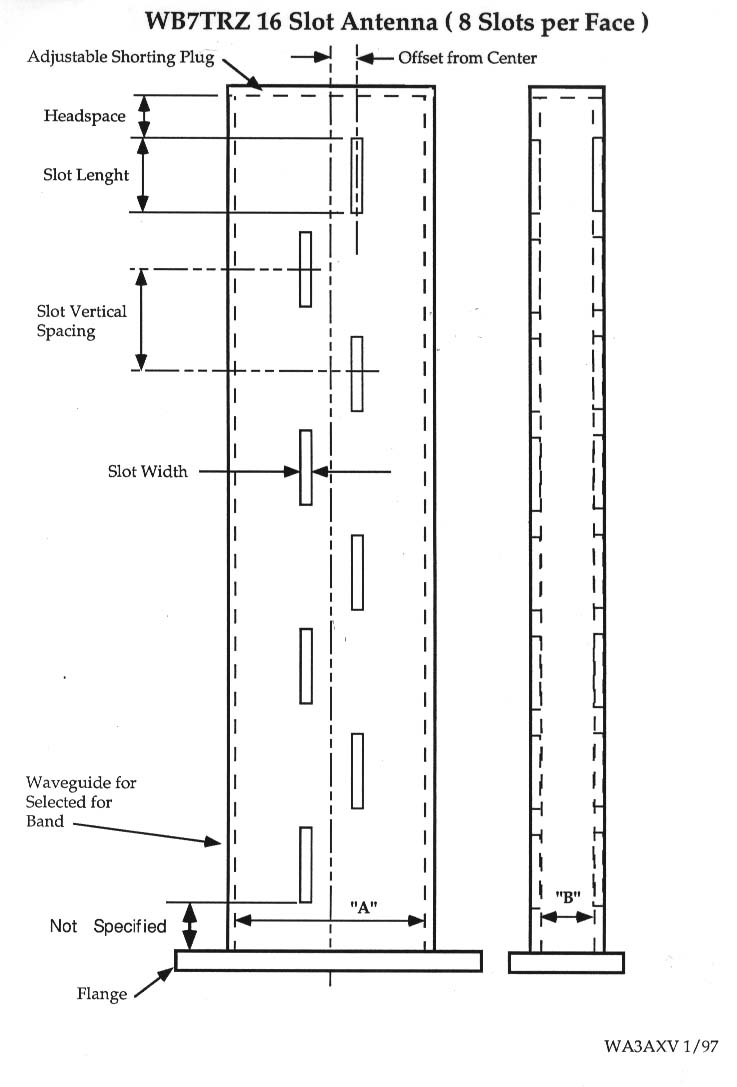|
Information below is from the old Brian Yee WEB page
Introduction This paper was presented at the 40th Annual West Coast VHF/UHF Conference held on May 5-7 (1995?) in Cerritos, CA. Some editing was done to make it suitable for this WEB page. Abstract Slot antennas can be used for fixed stations, satellite ground stations and beacons. With proper mounting, a slot antenna can also be used for ‘microwave mobile’. With a 16-slot total, the antenna can have 10-12 dBi gain. Slot antennas can be built from surplus waveguide sections, which will give an omni-directional pattern and horizontal polarization. This paper offers a computer aided method to calculate the proper dimensions for the slots and their locations. Because the antenna is of one-piece construction, it is rugged and can be built cheaply, requiring only access to a reasonably precise drill press or milling machine. (Note: A precise milling machine is almost a necessity…de W3RJW) Getting Ready The first step in construction of the antenna is to select a section of waveguide, which covers the desired frequency. Waveguide dimensions for several microwave bands are listed in table 1. If your waveguide doesn’t match the dimensions exactly, go ahead and run the program. The program will tell you if the waveguide is too small (if you attempt to operate a waveguide below its cutoff frequency, it will have unacceptable SWR and losses) |
||||||||||||||||||||||||||||||||||||||||||||||||||||||||||||||||||||||||||||||||||||||||||||||||||||||||||||||||||||||
| TABLE 1. Waveguide Dimensions | ||||||||||||||||||||||||||||||||||||||||||||||||||||||||||||||||||||||||||||||||||||||||||||||||||||||||||||||||||||||
|
||||||||||||||||||||||||||||||||||||||||||||||||||||||||||||||||||||||||||||||||||||||||||||||||||||||||||||||||||||||
|
Running the Computer Aided Design File Once the waveguide has been selected, just enter its cross-sectional dimensions and the desired operating frequency into MathCad program file *slot_ant.mcd or slot_a2.mcd. In order to edit the file and make the calculations, you must have a copy of MathCad running under MS Windows. The program file references the slot antenna dimensions shown in Figure 1. Note that all calculated dimensions (from the MathCad program) are given in both inches and millimeters. For the best pattern, a pair of ground planes (wings) can be added to either side of the antenna. The ‘wings’ should be flush with the top of the waveguide and extend at least a half wavelength below the bottom slot. The wings need to protrude out from the sides by several wavelengths, if possible. Machining the Slots Drill Press - "Just" drill many overlapping holes, then file out the slots to the desired dimensions. Milling Machine – The ideal method: fast and accurate, less prone to mistakes. Note: The front face and rear face slots are exactly across the waveguide from each other. You should be able to 'see through' any front/back pair of slots. Feeding the Antenna The simplest feed for the slot antenna is to use a coaxial to waveguide transition. These transitions are often available on the surplus market. (Note: Another method is build the antenna long on the bottom and use a N chassis mount jack and probe antenna to replicate a transition as part of the antenna …de W3RJW) |
||||||||||||||||||||||||||||||||||||||||||||||||||||||||||||||||||||||||||||||||||||||||||||||||||||||||||||||||||||||
| FIGURE 1. Front View of Waveguide Slot Antenna | ||||||||||||||||||||||||||||||||||||||||||||||||||||||||||||||||||||||||||||||||||||||||||||||||||||||||||||||||||||||
 |
||||||||||||||||||||||||||||||||||||||||||||||||||||||||||||||||||||||||||||||||||||||||||||||||||||||||||||||||||||||
| MathCad Software
There are two versions of the MathCad slot antenna program. It was discovered that the original program running on MathCad 3.1 had some problems when users tried to run it on later versions, namely Version 6.0, etc. For users of the older MathCad, use *slot_ant.mcd, otherwise use slot_a2.mcd. Many thanks to Steve Muther, WF6R, for getting the program running in MathCad 6.0. Ham Band Slot Antennas Here are some worked examples of waveguide slot antennas using the MathCad program by Stephen Bell. These examples are based on a 16-slot design (8 slots per face). All dimensions are in inches. |
||||||||||||||||||||||||||||||||||||||||||||||||||||||||||||||||||||||||||||||||||||||||||||||||||||||||||||||||||||||
|
||||||||||||||||||||||||||||||||||||||||||||||||||||||||||||||||||||||||||||||||||||||||||||||||||||||||||||||||||||||
| Below are several more antennas using the MathCad program. These are 32 slot antennas (16 Slots per Face ... de W3RJW | ||||||||||||||||||||||||||||||||||||||||||||||||||||||||||||||||||||||||||||||||||||||||||||||||||||||||||||||||||||||
|
||||||||||||||||||||||||||||||||||||||||||||||||||||||||||||||||||||||||||||||||||||||||||||||||||||||||||||||||||||||
| Below is an 8 Slot design for 2304 MHz (4 Slots per Face) ... de W3RJW | ||||||||||||||||||||||||||||||||||||||||||||||||||||||||||||||||||||||||||||||||||||||||||||||||||||||||||||||||||||||
|
||||||||||||||||||||||||||||||||||||||||||||||||||||||||||||||||||||||||||||||||||||||||||||||||||||||||||||||||||||||
| * Brian Yee's home page no longer exists as far as I can tell. Likewise, the links to the programs are also gone. Here is a link to a basic program that purports to perform the same calculations as the MathCad program.
http://www.ham-radio.com/sbms/sd/slotant.htm Here is a Visual Basic program that calculates the Slot Antenna parameters. This program was sent to me by Peter, VK3KCG. Click here to download. de W3RJW |
||||||||||||||||||||||||||||||||||||||||||||||||||||||||||||||||||||||||||||||||||||||||||||||||||||||||||||||||||||||